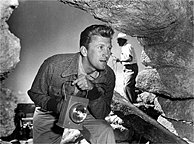Alessandra Stanley Falls On Her Bayonet
Today's jaw-dropper is Alessandra Stanley's review of the new FX series on Iraq, Over There. With a flick of her wrist, she obliterates an entire genre of motion pictures.
The point of Stanley's review is that explicit combat scenes, portrayed during the war, set "Over There" apart.
With a stroke of her word processor, she wipes out Sahara, Objective Burma, Guadalcanal, Thirty Seconds Over Tokyo, The Story of GI Joe and many, many others. They were far more numerous than "home front" films like Mrs. Miniver.
Though not depicting blood and gore and guts, these movies sometimes were quite graphic in showing the tragedy and horror of war. GI Joe, based on the writings of Ernie Pyle, is a good example.
What astonishes me is that this woman is a New York Times popular culture critic, and she --and the dozens of editors who read her piece -- are so abysmally ignorant of the history of motion pictures.
The point of Stanley's review is that explicit combat scenes, portrayed during the war, set "Over There" apart.
During World War II, many war movies were made long before its outcome was known: "Mrs. Miniver," "Casablanca" and "In Which We Serve" were released in 1942. Back then, wartime films focused on survivors and civilians struggling on the home front; neither Hollywood nor the War Department wanted to demoralize audiences with too graphic a depiction of what their servicemen were likely to endure.That's simply not true. Dozens of movies made during World War II depicted combat sequences. Now, the second part of what she says is true. World War II combat movies were notorious for their unrealistic portrayal of combat. Still, they existed.
With a stroke of her word processor, she wipes out Sahara, Objective Burma, Guadalcanal, Thirty Seconds Over Tokyo, The Story of GI Joe and many, many others. They were far more numerous than "home front" films like Mrs. Miniver.
Though not depicting blood and gore and guts, these movies sometimes were quite graphic in showing the tragedy and horror of war. GI Joe, based on the writings of Ernie Pyle, is a good example.
What astonishes me is that this woman is a New York Times popular culture critic, and she --and the dozens of editors who read her piece -- are so abysmally ignorant of the history of motion pictures.


<< Home